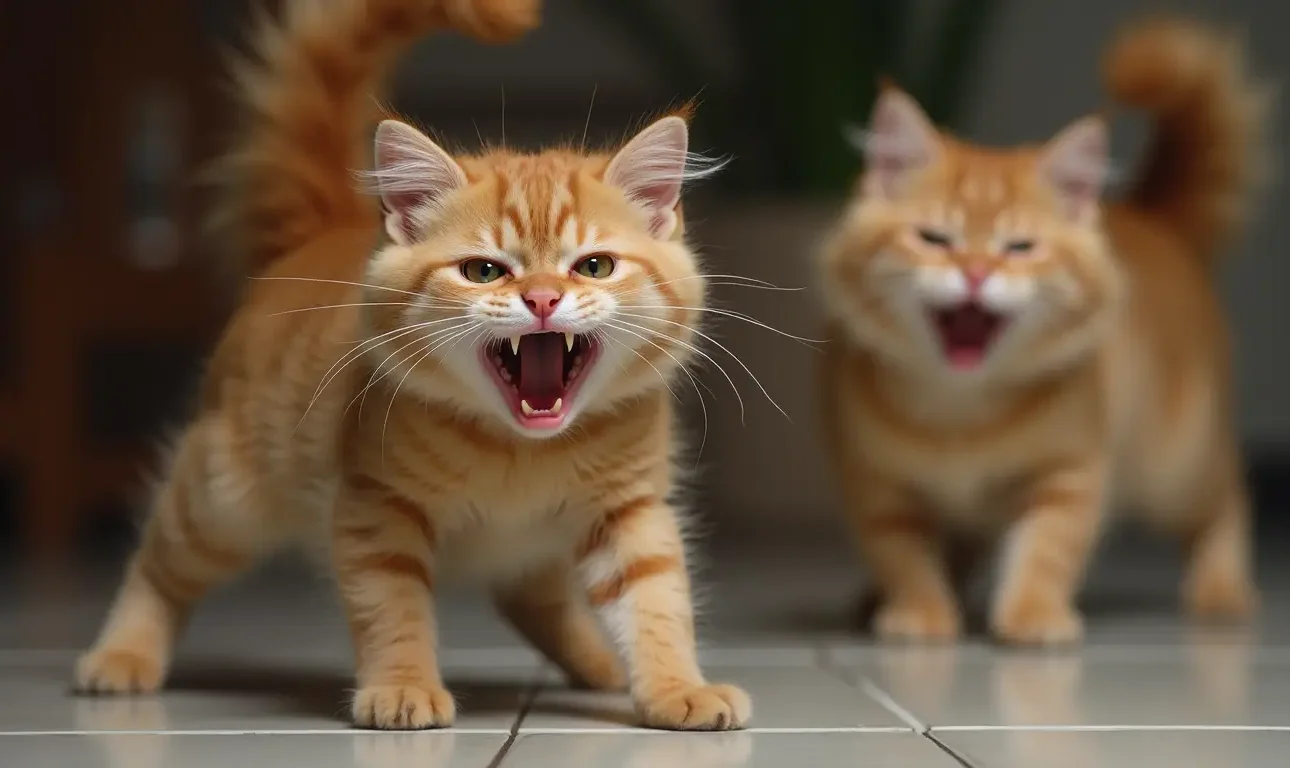Cats are known for their fascinating and often mysterious behaviors, many of which are tied to their survival instincts. One of the most striking and easily recognizable responses in felines is when they raise their fur—also known as “piloerection”—during a fight or in response to a perceived threat. This sudden puffing up of their coat can be both surprising and puzzling to cat owners. However, this behavior is far from random; it’s an essential part of a cat’s defense mechanism. Understanding Why do cats raise their hair in a fight can shed light on their complex communication system and give us a deeper appreciation for their instincts. Whether they’re defending their territory or simply feeling scared, the act of “puffing up” plays a critical role in how cats protect themselves from danger.
Table of Contents
What Happens When a Cat Raises Its Fur?
Piloerection Explained
Piloerection, often referred to as “hackles up” or simply “raising fur,” is a natural physiological response in cats that occurs when certain muscles at the base of their hair follicles contract. This action causes the fur to stand upright, giving the cat a puffed-up appearance. These tiny muscles, known as arrector pili muscles, are part of the cat’s autonomic nervous system and are involuntarily activated during moments of fear, aggression, or excitement. The process of piloerection is an instinctive behavior that serves as a defensive mechanism, helping the cat to appear larger and more intimidating to potential threats.
Feline Body Language in Defense
When a cat feels threatened, it communicates its discomfort through a series of body language signals. One of the most visible signs is the raising of their fur, but it is typically accompanied by other defensive postures. A cat will often arch its back, puffing out its body to make itself appear bigger, while its tail may stand upright or become bushy. Cats may also hiss or growl to further warn an intruder or rival. These behaviors all serve as visual and auditory cues that the cat is feeling cornered or unsafe. Raised fur, combined with a defensive stance, sends a strong message that the cat is prepared to defend itself if necessary.
The Fight or Flight Response
The raising of a cat’s fur is closely linked to the “fight or flight” response, an instinctual reaction that occurs when the cat perceives a threat. When faced with a dangerous or intimidating situation, the body prepares for one of two outcomes: to confront the threat (fight) or to escape from it (flight). For cats, the response is triggered by the release of stress hormones like adrenaline. In the case of a fight, the fur raises to make the cat appear larger and more formidable. In situations where flight is more appropriate, the raised fur may signal the cat’s readiness to flee if the threat intensifies. Essentially, piloerection is an outward manifestation of the internal stress the cat is experiencing, signaling its heightened awareness and readiness to act.
Why Do Cats Raise Their Hair in a Fight?
Aggressive Behavior as a Defense Mechanism
When a cat raises its fur during a confrontation, it’s using a natural defense tactic designed to make it appear larger and more threatening. This behavior, a result of piloerection, is an instinctual response that helps the cat assert dominance or warn off potential threats without engaging in a full-blown physical altercation. In the wild, this strategy is crucial for survival, as appearing more intimidating can discourage rivals or predators from initiating a fight. Even domesticated cats, who may not often face life-threatening situations, retain this behavior as part of their evolutionary instincts. By puffing up its fur, a cat signals that it’s ready to defend itself, making it less likely to be attacked.
Physical Signals of Aggression
Raised fur is just one of several physical signals a cat uses to communicate aggression or fear. When cats feel threatened, their bodies react with a combination of defensive postures and vocalizations designed to protect them from harm. Alongside the puffed-up fur, a cat might arch its back, puff out its chest, and make itself look bigger. Its tail might become stiff and stand erect, or it could lash back and forth aggressively. A hissing sound, often accompanied by bared teeth, is another clear signal of distress or warning. These signs indicate that the cat is in a heightened state of alert, preparing for a potential fight, and it is not to be approached or challenged further.
Understanding Cat Fights
Cats are territorial animals, and many of their confrontations stem from disputes over space or resources, such as food, shelter, or mates. When a cat perceives another cat as a rival or threat, it may raise its fur as part of the escalation leading to a fight. However, not all cat fights are physical. Often, a show of aggression—such as raised fur, hissing, and other intimidating body language—can be enough to establish dominance and avoid injury. In these situations, the raised fur serves as a warning: “I’m ready to fight if you push me, but I’d prefer to avoid it.” This behavior is a crucial part of their social structure, as cats tend to avoid the risks of a direct physical confrontation unless absolutely necessary.
What Triggers a Cat to Puff Up and Show Aggression?
Environmental Stressors
Cats are highly sensitive creatures, and various environmental stressors can trigger a defensive response, causing them to puff up and exhibit signs of aggression. Common triggers include unfamiliar territory, such as when a cat is introduced to a new home or area where it doesn’t feel safe. Other animals, especially other cats or dogs, can pose a threat and provoke a defensive response. Additionally, loud noises—like thunderstorms, fireworks, or even sudden household sounds—can startle a cat and make it feel vulnerable. In these situations, the cat’s instinct is to appear larger and more threatening by raising its fur, signaling that it’s ready to defend itself if needed.
Fear vs. Aggression
It’s important to differentiate between fear-based behavior and true aggression when a cat raises its fur. Fear-based behavior typically occurs when a cat feels threatened but is not necessarily looking to fight. It may puff up as a warning to make itself appear more intimidating, yet it could still be willing to flee if the situation worsens. On the other hand, true aggression occurs when a cat feels it must defend itself or its resources, and the raised fur is part of an all-out threat display. While both fear and aggression can cause a cat to puff up, the key difference lies in the cat’s intent: fear indicates the cat is trying to protect itself from harm, whereas aggression suggests it’s preparing to take action.
Overstimulation in Cats
Overstimulation or frustration can also cause a cat to react defensively, leading to raised fur and aggression. This happens when a cat is overstimulated by excessive petting, play, or even frustration from not getting what it wants (like food or attention). In these instances, the cat may become agitated and react defensively, even though it wasn’t initially threatened. Overstimulation can cause a cat to shift quickly from calm to aggressive, raising its fur, hissing, and even swatting as a way of signaling that it has reached its tolerance limit. Understanding your cat’s body language and respecting its boundaries can help prevent these types of reactions.
How to Calm a Cat That Raises Its Fur in a Fight
Recognizing the Signs of Stress
The first step in calming a cat that raises its fur in a fight is recognizing the early warning signs that the cat is feeling stressed or threatened. In addition to raised fur, watch for hissing, growling, or a stiff posture, as these are common signs that a cat is feeling defensive or anxious. Tail flicking or a rigid tail can also indicate agitation. If your cat’s body is arched, with its ears flattened back or facing forward, it’s likely a sign that it is preparing to defend itself. By observing these signals, you can gauge when a cat is beginning to feel uncomfortable, allowing you to intervene before the situation escalates.
Preventing Feline Aggression
Preventing feline aggression involves addressing potential stressors early and ensuring that your cat feels safe and secure in its environment. Gradual introductions are key if you’re bringing a new pet or person into the home. Allow the cat to adjust to the presence of others at its own pace and use positive reinforcement to reward calm behavior. Calming pheromones, available as sprays or diffusers, can help create a more relaxed atmosphere for your cat. Providing safe spaces—like quiet areas with hiding spots—can also help a stressed cat feel less threatened. Additionally, interactive play and environmental enrichment can keep your cat mentally stimulated, reducing the likelihood of frustration and aggression.
When to Seek Help from a Professional
If your cat’s aggression becomes frequent, unmanageable, or seems to escalate over time, it may be time to consult a veterinarian or animal behaviorist. Some cats may develop behavioral problems due to underlying health issues, such as pain or illness, so it’s important to rule out medical causes. A veterinarian can assess whether there are any physical health factors contributing to your cat’s aggression. If no health problems are found, an animal behaviorist can work with you to develop a strategy for managing and modifying aggressive behavior. In some cases, professional help may be necessary to prevent harm to other pets, family members, or even the cat itself.
Conclusion
In conclusion, cats raise their fur during a fight as part of a natural defense mechanism, aiming to appear larger and more intimidating to potential threats. This behavior, known as piloerection, is deeply rooted in their instinct for survival and can be triggered by fear, aggression, or environmental stressors. By recognizing the physical signs of stress and aggression, such as raised fur, hissing, or a stiff posture, cat owners can better understand their feline companions and prevent confrontations. Additionally, creating a calm environment, using gradual introductions, and utilizing calming pheromones can help reduce the likelihood of aggression.
Understanding feline behavior is essential not only for managing stressful situations but also for ensuring a cat’s overall well-being. By being attentive to the signs of stress and intervening when necessary, cat owners can help minimize anxiety and create a safe, comfortable environment for their pets. Ultimately, this knowledge fosters a deeper bond between humans and cats, leading to a more harmonious relationship.
Frequently Asked Questions (FAQ)
1. Why do cats raise their fur during a fight? Cats raise their fur, a behavior known as piloerection, to appear larger and more intimidating to potential threats. It is a natural defense mechanism that helps them protect themselves by signaling that they are ready to fight if necessary.
2. What does it mean when a cat’s fur stands up, but it’s not fighting? When a cat’s fur stands up without a fight, it could be a sign of fear, anxiety, or excitement. This behavior is still part of the cat’s defensive instincts, signaling that they feel threatened or startled, even if they aren’t engaging in physical combat.
3. How can I tell if my cat is scared or aggressive? A scared cat may exhibit defensive behaviors like raised fur, flattened ears, and wide eyes, while showing signs of retreat or wanting to avoid the confrontation. An aggressive cat, on the other hand, may raise its fur while also hissing, growling, or swatting, signaling that it is prepared to engage in a fight.
4. Can overstimulation cause a cat to raise its fur? Yes, overstimulation can trigger a cat to raise its fur. Cats may become agitated or frustrated during excessive petting or play, leading to defensive behaviors like puffing up their fur, hissing, or swatting. It’s important to recognize when a cat has had enough stimulation to prevent these reactions.
5. How do I prevent my cats from fighting? To prevent fighting between cats, it’s important to make gradual introductions, provide enough space for each cat, and ensure they have separate food, water, and litter areas. Using calming pheromones or interactive toys can help alleviate stress and promote positive behavior.
6. When should I seek help from a professional about my cat’s aggression? If your cat’s aggression becomes frequent, intense, or unmanageable, or if you notice behavioral changes that seem out of character, it’s time to consult a veterinarian or animal behaviorist. Aggression can sometimes be linked to underlying health problems, and a professional can help develop a management plan.
7. Can stress or fear cause a cat to raise its fur without a fight? Yes, stress or fear can lead to piloerection. Even if a cat isn’t directly engaging in a fight, the raised fur may be a sign of their heightened state of alert and an instinctual response to a perceived threat, like an unfamiliar environment, noise, or person.






